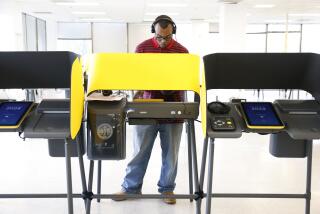Editorial: What the June primary tells us about California’s top-two system
It’s the day after California’s primary election, and although dawn broke on clear winners in some races — most notably the gubernatorial race, where Democrat Gavin Newsom and Republican John Cox prevailed — others are still up in the air and may remain so for days.
Among the cliffhangers: Will Democratic state Sen. Kevin de León maintain his small edge over Republican James Bradley and face a fellow Democrat, U.S. Sen. Dianne Feinstein, in November? Will Democrats do well enough in congressional races to make flipping the U.S. House a real possibility? In a few congressional races, it’s not even certain a Democrat will make the cut for the general election. Will a Republican squeak into the runoff for lieutenant governor, or will it be two Democrats competing?
The fact that some races are still too close to call is, at least in part, a function of new rules that allow mail-in ballots to arrive at the registrar’s office up to three days after the election and still be counted. And voting by mail has become increasingly common. This year, about 11.8 million ballots were sent out to voters, and as of Tuesday fewer than 3 million had been returned. That leaves a lot of room for uncertainty.
There’s another thing at play here: unusually competitive races. For that, we can thank two forces: Donald Trump, whose election in 2016 inspired many first-time candidates to seek elective office in order to foil his agenda, and California’s top-two primary system.
The former is a one-time event (at least, we hope it is). The latter, adopted eight years ago, allows voting across party lines in primaries and sends the two highest vote-getters, regardless of party, to duke it out in the November general election.
The would-be power brokers who run our political parties don’t like top-two because it diminishes their ability to influence the general election. Instead of closed primaries in which only members of that party can vote — and where candidates anointed by the party establishment have a considerable advantage — the top-two primaries allow any registered voter to vote for any candidate on the ballot regardless of the party affiliation. Meanwhile, Greens, Libertarians and members of other third parties hate it because their candidates rarely win spots in the runoff elections.
The Los Angeles Times supported the top-two system when Proposition 14 was on the ballot in 2010, saying that it was unlikely to be either a miracle cure for political gridlock or the end of democracy as we know it, but a modest step toward getting rid of the worst partisanship. We hoped it would encourage lawmakers to compromise more because successful candidates would have to hold positions that appealed not just to their most fervent party stalwarts, but to voters from a range of parties and ideologies.
Opponents of Proposition 14 worried that it would end up protecting incumbents. This year, at least, it appears to be having the opposite effect. Would de León, a former president pro tem of the state Senate, have launched a challenge to a sitting U.S. senator if he knew he’d have little chance to advance past the primary to the general election? Would Feinstein have taken more liberal views on recreational marijuana and the death penalty if she didn’t have a challenger on the left? Feinstein said it has nothing to do with the race, but we are not so sure.
If there were no top-two primary to threaten incumbent Rep. Dana Rohrabacher (R-Costa Mesa), would former Orange County GOP Chairman Scott Baugh and other Republicans have decided to enter the race? We’re not saying it’s good or bad, only that it couldn’t have happened under the old primary system. (And it didn’t appear to work — unofficial returns have Rohrabacher facing a Democrat in November, not a fellow Republican.)
In the end, the vast majority of the races in this primary produced the same outcome as the pre-top-two system: one Democrat and one Republican heading to the general election, albeit without potential third-party spoilers. Nevertheless, after the dust from this election has settled, it would be appropriate to take a closer look at how top-two has fared in its first eight years, particularly as this was the first test of it in an open gubernatorial race. Proposition 14 was passed the same year Jerry Brown was elected for the third time as governor. Will top-two continue to deliver competitive races? Will these produce better candidates? Will partisan gridlock return to the California Legislature? Will a Green candidate ever have a shot at the general election? These are questions worth asking, not just now but after every election.
Follow the Opinion section on Twitter @latimesopinion and Facebook
More to Read
A cure for the common opinion
Get thought-provoking perspectives with our weekly newsletter.
You may occasionally receive promotional content from the Los Angeles Times.






